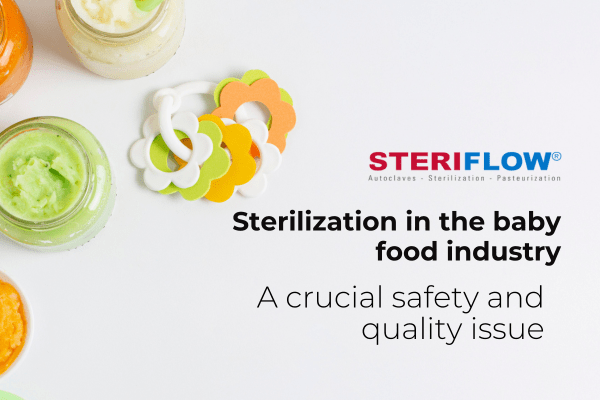Baby food sterilization in the food industry

As a baby food manufacturer, you understand the critical importance of ensuring food safety while preserving the organoleptic properties of your products to gain parents’ trust. Purées, complete meals, and compotes must be flawless. Choosing the right sterilization solution is therefore an important step in your manufacturing process.
Baby Food: Why Sterilize?
Sterilizing baby food is a precautionary measure to eliminate potentially dangerous bacteria and spoilage germs that could be present in the food. Babies have a less mature immune system than adults, making them more vulnerable to diseases and infections. Manufacturers therefore turn to sterilization, particularly autoclave sterilization. This ensures food safety by eliminating all microorganisms.
Sterilization also offers practical advantages, such as:
- Ability to store at room temperature,
- Easy to takeaway.
Baby Food: Sterilization Process
In food processing factories, heat treatment of baby food is carried out using a high-temperature sterilization process. One of the most commonly used processes for this application is sterilization by superheated cascading water.
This process is particularly appreciated by manufacturers because it offers many advantages:
- It can treat all types of packaging while maintaining their integrity and without risk of distortion, thanks to independent of temperature pressure control in the autoclave.
- It avoids thermal shocks on glass, thus preventing breakage risks.
- It allows excellent temperature homogeneity in the retort and consequently perfectly uniform heat treatment of the load.
- The rotary autoclave – in addition to all the advantages related to cascading – improves the organoleptic quality of products by reducing overcooking.
 Different Stages of Sterilization
Different Stages of Sterilization
The baby food sterilization process includes several phases:
- Pre-treatment: raw food materials are washed, peeled, cut, and then prepared according to your recipes
- Filling: foods are filled into their containers, which are then hermetically sealed, usually in glass jars, pouches, or plastic trays
- Sterilization: containers are placed in the autoclave to be treated to a predetermined Time/Temperature schedule
- Cooling: products are rapidly cooled to avoid deterioration of the food’s organoleptic qualities
Baby Food: What Are the Food Safety Standards?
Specific regulations apply to infant nutrition with very restrictive standards, particularly regarding additives (preservatives, colorants, sweeteners), pesticide residues, or nitrate content.
These standards are defined by national and international health authorities, such as the French National Agency for Food, Environmental and Occupational Health Safety (ANSES) or the Food and Drug Administration (FDA) in the United States.
They are extremely important and must be strictly followed to ensure the health and safety of children. Baby food must be free from any contaminants, whether bacteria, viruses, or chemicals.
These standards include:
- Regular quality controls of ingredients
- Inspections of manufacturing facilities and equipment used for baby food production Baby food sterilization

FAQ
 What types of baby food require sterilization?
What types of baby food require sterilization?
Vegetable purées, complete meals, and milk-based products require sterilization. Foods, regardless of their container, must undergo this treatment to eliminate potential microbiological hazards and ensure optimal preservation.
 What are the criteria for choosing containers for sterilizing baby food in industrial autoclaves?
What are the criteria for choosing containers for sterilizing baby food in industrial autoclaves?
When choosing containers for sterilizing baby food in industrial autoclaves, several criteria are essential to ensure effective sterilization and optimal preservation. These include the packaging material, seal integrity, autoclave compatibility, ease of handling, and compliance with safety standards.
 What are the impacts of sterilization on vitamins and nutrients present in baby food?
What are the impacts of sterilization on vitamins and nutrients present in baby food?
Sterilization can destroy some heat-sensitive vitamins, such as vitamin C. However, this process ensures the preservation of the nutritional quality of products. Food companies optimize temperature and pressure parameters to minimize the loss of nutritional quality while killing microorganisms.
 What are the common challenges in industrial sterilization of baby food?
What are the common challenges in industrial sterilization of baby food?
Frequently encountered challenges include maintaining nutritional quality while ensuring the destruction of microorganisms, and temperature and pressure constraints that can impact packaging.
 How do industries verify that sterilized baby food products meet quality standards?
How do industries verify that sterilized baby food products meet quality standards?
Food industries conduct rigorous quality control tests. Samples are analyzed to verify the absence of microorganisms and the preservation of nutritional properties. Traceability documents and regular audits are part of this process.
 How long can sterilized baby food jars be safely stored?
How long can sterilized baby food jars be safely stored?
Sterilized baby food jars can be stored for several months at room temperature. The shelf life depends on storage conditions and the type of food, but sterilization allows for long-term storage without risk to infant health.
